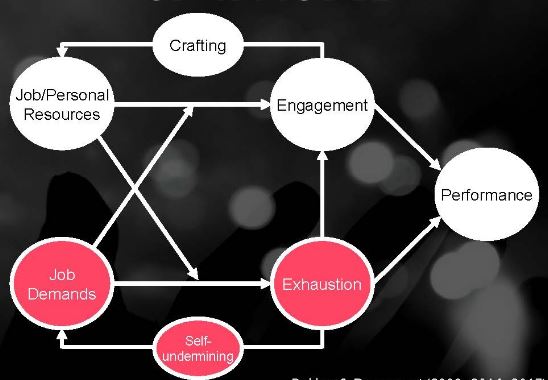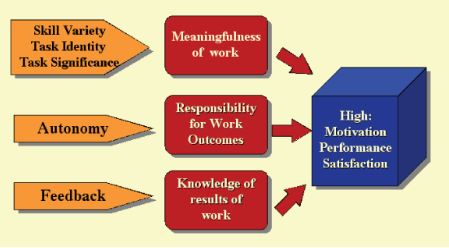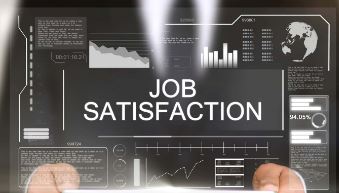Implementing Positive Working Environment means creating an environment that is relatively enjoyable and productive. This most certainly also means creating a work schedule that does not lead to emotional and/or physical distress. In this article we are going to be touching basis on:
- Promoting Positive Affect
- United States Department of Labor
- Demands, Resources, and Characteristics
- Preventing Burnout and Encouraging Engagement
Promoting Positive Affect
 Positive energy in the workplace is about shifting attention away from negative aspects such as work violence, stress, burnout, and job insecurity. Through the employment of positive energy, a working environment with a goal of promoting positive affect in its employees can be created.
Positive energy in the workplace is about shifting attention away from negative aspects such as work violence, stress, burnout, and job insecurity. Through the employment of positive energy, a working environment with a goal of promoting positive affect in its employees can be created.
Fun should not be looked at as something that cannot be achieved during work but rather as a motivation factor for the staff. Along this line, it is important to examine the role of: helping behaviors, team building exercises, job resources, job security and work support.
The emerging field of positive energy also helps to creatively manage organizational behaviors and to increase productivity in the workplace through applying positive organizational forces. Recent researches on job satisfaction and employee retention have created a great need to focus on implementing positive energy in the workplace.
United States Department of Labor
 The United States Department of Labor (DOL) is a cabinet-level department of the U.S. federal government responsible for occupational safety, wage and hour standards, unemployment insurance benefits, reemployment services, and some economic statistics; many U.S. states also have such departments. The department is headed by the U.S. Secretary of Labor.
The United States Department of Labor (DOL) is a cabinet-level department of the U.S. federal government responsible for occupational safety, wage and hour standards, unemployment insurance benefits, reemployment services, and some economic statistics; many U.S. states also have such departments. The department is headed by the U.S. Secretary of Labor.
According to the United States Department of Labor, “In 2009 employed persons worked an average of 7.5 hours on the days they worked, which were mostly weekdays. [In addition to that], 84 percent of employed persons did some or all of their work at their workplace”. This indicates that majority of the population spend their waking hours at work, outside their homes. Therefore, employers must do their best to create a low stress and inspiring work environment to yield greater productivity.
Michelle T. Iaffaldano and Paul M. Muchinsky were among the first people to ignite interest in the connection between job satisfaction and job performance. The meta-analytic research of these individuals impacted the way in which later research on the topic was conducted, especially regarding sample sizes.
Job satisfaction
Job satisfaction or employee satisfaction is a measure of workers’ contentedness with their job, whether or not they like the job or individual aspects or facets of jobs, such as nature of work or supervision. Job satisfaction can be measured in cognitive (evaluative), affective, and behavioral components. Researchers have also noted that job satisfaction measures vary in the extent to which they measure feelings about the job. or cognitions about the job.
Demands, Resources, and Characteristics
Demand control model
 Robert A. Karasek is credited with this particular work design model. In Karasek’s model, workplace stress is in indicator of how taxing a worker’s job is and how much control, authority, discretion, and decision latitude the worker has over his/her tasks and duties. This creates four kinds of jobs—passive, active, low strain and high strain The Demand Control Model (DCM) has been used by researchers to design jobs that enhance the psychological and physical well-being. This model promotes a work design that proposes high demand and high control, fostering an environment that encourages learning and simultaneously offers autonomy.
Robert A. Karasek is credited with this particular work design model. In Karasek’s model, workplace stress is in indicator of how taxing a worker’s job is and how much control, authority, discretion, and decision latitude the worker has over his/her tasks and duties. This creates four kinds of jobs—passive, active, low strain and high strain The Demand Control Model (DCM) has been used by researchers to design jobs that enhance the psychological and physical well-being. This model promotes a work design that proposes high demand and high control, fostering an environment that encourages learning and simultaneously offers autonomy.
This model is based on the assumption that “workers with active jobs are more likely to seek challenging situations that promote mastery, thereby encouraging skill and knowledge acquisition”. It also points out the role of social support, referring to the quality interactions between colleagues and managers. However, there is some controversy over this model because some researchers believe it lacks evidence for the interaction between demand and control.
The DCM is commonly criticized for its inability to consistently replicate findings to support its basic assumption. The DCM has been criticized for “its simplicity, inability to capture the complexity of work environments.However, there is evidence supporting the idea that “high amounts of job control is associated with increases in job satisfaction and decreased depression, however, high demands with out adequate control may lead to increase anxiety”.
Job demands-resources
 The job demands-resources model (JD-R) is an expansion of the DCM and is founded on the same principle that high job demands and high job resources produce employees with more positive work attitudes. The difference between the JD-R and DCM is that the JD-R expounds upon the differentiation between demand and resources, as well as encompasses a broader view of resources. This model refers to demands as “ those physical, psychological, social, or organizational aspects of the job that require sustained physical and/or psychological effort. This may refer to jobs that require contact with customers. Resources are regarded as “those physical, psychological, social, or organizational aspects of the job that are either/or: (1) functional in achieving work goals; (2) reduce job demands and the associated physiological and psychological costs; and (3) stimulate personal growth, learning, and development”. Another difference between these two theories is that the JD-R postulates that resources can be predictors of motivation and learning related outcomes. The findings by Bakker and colleagues supports their hypothesis that many resources may be linked to job well-being. They also found that “task enjoyment and organizational commitment are the result of combinations of many different job demands and job resources. Enjoyment and commitment were high when employees were confronted with challenging and stimulating tasks, and simultaneously had sufficient resources at their disposal”.
The job demands-resources model (JD-R) is an expansion of the DCM and is founded on the same principle that high job demands and high job resources produce employees with more positive work attitudes. The difference between the JD-R and DCM is that the JD-R expounds upon the differentiation between demand and resources, as well as encompasses a broader view of resources. This model refers to demands as “ those physical, psychological, social, or organizational aspects of the job that require sustained physical and/or psychological effort. This may refer to jobs that require contact with customers. Resources are regarded as “those physical, psychological, social, or organizational aspects of the job that are either/or: (1) functional in achieving work goals; (2) reduce job demands and the associated physiological and psychological costs; and (3) stimulate personal growth, learning, and development”. Another difference between these two theories is that the JD-R postulates that resources can be predictors of motivation and learning related outcomes. The findings by Bakker and colleagues supports their hypothesis that many resources may be linked to job well-being. They also found that “task enjoyment and organizational commitment are the result of combinations of many different job demands and job resources. Enjoyment and commitment were high when employees were confronted with challenging and stimulating tasks, and simultaneously had sufficient resources at their disposal”.
Job characteristics model
 The job characteristics model (JCM) is “an influential theory of work design developed by Hackman and Oldham. It is based upon five characteristics – skill variety, task identity, task significance, task autonomy, and task feedback – which are used to identify the general content and structure of jobs”. This model argues that employees with a personal need for growth and development, as well as knowledge and skill, will display more positive work outcomes. These include things such as: job satisfaction, lower absenteeism, and better work turnover. This model is based upon an idea that high task control and feedback are two essential elements for maximizing work potential. Stronger experiences of these five traits is said to lead to greater job satisfaction and better performance.
The job characteristics model (JCM) is “an influential theory of work design developed by Hackman and Oldham. It is based upon five characteristics – skill variety, task identity, task significance, task autonomy, and task feedback – which are used to identify the general content and structure of jobs”. This model argues that employees with a personal need for growth and development, as well as knowledge and skill, will display more positive work outcomes. These include things such as: job satisfaction, lower absenteeism, and better work turnover. This model is based upon an idea that high task control and feedback are two essential elements for maximizing work potential. Stronger experiences of these five traits is said to lead to greater job satisfaction and better performance.
Preventing Burnout and Encouraging Engagement
 In order to protect the physical and mental health of workers, the demands of the job must be balanced by easily accessible job resources in order to prevent burnout in employees yet encourage employee engagement. The interaction between the demand and resources within a job determines employee engagement or burnout. Engagement signifies a positive employee who is committed to the safety within the workplace for self and others. In contrast, burnout represents a negative employee possessing elements of anxiety, depression, and work-related stress. Engagement increases as job resources like knowledge of safety are present. On the other hand, burnout increases when more job demands are present without the buffering effects of job resources.
In order to protect the physical and mental health of workers, the demands of the job must be balanced by easily accessible job resources in order to prevent burnout in employees yet encourage employee engagement. The interaction between the demand and resources within a job determines employee engagement or burnout. Engagement signifies a positive employee who is committed to the safety within the workplace for self and others. In contrast, burnout represents a negative employee possessing elements of anxiety, depression, and work-related stress. Engagement increases as job resources like knowledge of safety are present. On the other hand, burnout increases when more job demands are present without the buffering effects of job resources.
Hazards in the workplace can be seen as a combination of the physical demands of the work and the complexity of the work. Job resources provide a buffering effect that protects the employees from job demands like high work pressure, an unfavorable physical environment, and emotionally demanding interactions. Employees are better equipped to handle changes in their work environment when resources are readily available. The resources a job can provide include autonomy, support, and knowledge of safety. Autonomy allows employees the freedom to decide how to execute their work. Support can originate directly from a supervisor or from other workers in the environment. And lastly, employees must have knowledge about safety procedures and policies. When the employee is able to work in a safe environment, workers are more satisfied with their jobs. A safe environment provides support and resources that promote healthy employees.
In Closing
 The multitudes of research and new, developing information detailing the possibility of positive psychology at work often deals with reporting workplace safety, the engagement of the employees, productivity, and overall happiness.
The multitudes of research and new, developing information detailing the possibility of positive psychology at work often deals with reporting workplace safety, the engagement of the employees, productivity, and overall happiness.
Occupational safety and health (OSH), also commonly referred to as health and safety, occupational health and safety (OHS), occupational health, or occupational safety, is a multidisciplinary field concerned with the safety, health, and welfare of people at work. These terms also refer to the goals of this field, so their use in the sense of this article was originally an abbreviation of occupational safety and health program/department etc.
Moreover, understanding the significance of a healthy work environment can directly provide and contribute to work mastery and work ethic. Motivation, researchers have learned, helps to keep a reinforced sense of both discipline and a higher perception which then yields to higher levels of efficiency for both employees and employers.
I hope that you have really enjoyed this post,
Please Leave All Comments in the Comment Box Below ↓












I believe this is what we need in the workplace, and that is more people being positive that will also help others not only to get through the day, but will help them to be more productive in their work.
It is so good to let this positive energy start with us, as we pass it on to others, and then they, in-turn, will pass it on also. Being positive is a good thing that we should strive for in every area of our lives including the workplace.
Hi,
Thanks for the comment. Feel free to always check out my site for the most updated, and need to know information. I also agree with you, that being positive is a good thing that we should strive for in every area of our lives including the workplace.
Abundant Regards To You My Friend!
During my career days, management often had discussions with the staff on how to improve working conditions. Nearly always, the main conclusion from the staff was that management was quick to complain and reprimand and slow to show appreciation.
One of the crass management comments sometimes doled out was that the employees were paid to do what they do and that their paycheck was the best sign of appreciation. Comments like that went down like a lead balloon.
The more enlightened management agreed that they needed to do a better job in first recognizing when a job was well done. And then, letting that employee know that their good work was recognized.
One of the best ways teams were rewarded was by buying them lunch. Or better yet, giving them bonuses.
At Walmart for example, the profits at each store are tracked, And when they beat expectations every quarter, bonuses are given to all the employees at that store, the amount scaled to their income. This small gesture went a long way to elicit pride and more conscientious workers.
When employees are recognized for good results, that indeed, creates a positive working environment..
Cheers.
Edwin
Welcome again Edwin,
It is always my pleasure to receive your feedback.
Your comment reminded me of my leadership career in the military, that I retired from some years ago. While in a leadership position, I planned to make sure I informed my subordinates about the positive things they were doing, as well as constructively informing them about the negative things, if there were any, and a suggested solution of how to correct them.
Even though I have been retired for awhile, I still receive calls and messages form from those who were my subordinates at the time, thanking me for the leadership I provided, and they often tell me what they have learned form me.
I can imagine that I must have been successful in creating a Positive Working Environment for each of them.
Thank you again for your feedback,
Many Blessings and Much Success To You!
Hello Jerry,
Boy could we use you to come in and do a talk about a positive working environment with all our employees and management. This place has zero positivity, no team aspect, our bosses suck and can not communicate very well.
We have employees only looking out for themselves and could care less for a fellow courier, it is just sad that the workplace is turning into this today.
I don’t know if its the millennials that think everything should be given, not earned, and the older generations that don’t know how to communicate without sounding old or abusive.
I am glad I found your article, I am going to implement some of your points and see if there is a difference at the workplace, if not, we will be giving you a call to come in and help.
Thanks for your information.
Hey,
Thank you so much for reading, commenting and enjoying this post. I agree with your comment whole heartedly about employees and management needing this information presented to them in order to remind them of the importance of a Positive Working Environment!
You are most certainly welcome for the sharing of this informative post, and thank you for considering it such. I am also thankful that you have stumbled upon this website, in which you can bookmark if you like, and I am hopeful that the information contained in it will continue to be very helpful to you in the future as well.
GOD Bless!
Nothing feels better than having to work in the right environment.
It can help to generate the right needed energy and source to make the right exploit and all. I quite frankly agree with you that with a positive environment, productivity would surely be more prone to happen.
Very informative post here and I value it a lot.
Thanks
Welcome,
Thanks for leaving a comment on Positive Working Environment.
Favor Filled Blessings To You!
You have some great ideas for developing a positive work environment.
Having a place where employees feel safe and appreciated is so important. It was also mentioned that Job security is important which I agree with, but I also think it is critical to remove employees that fail to meet standards.
One employee who is always complaining and finding the negative can bring the whole business down. Other situations that should result in removing an employee or manager is if they use threats to coerce fellow employees.
Hello,
Thanks for your comment, as well as your discussion on the subject matter. I definitely agree.
All The Best,
Jerry